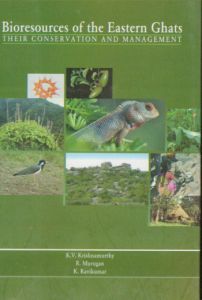
Contents: Preface. 1. Extent delimitation constituent hill ranges and physiographic organization. 2. Geology georesources and climate. 3. Forest and vegetation types and landuse patterns. 4. Flora and plant resources. 5. Fauna and animal resources. 6. Tribals and traditional knowledge resources. 7. Microbes and microbial resources. 8. Biogeography. 9. Degradation of environment and loss of biodiversity. 10. Conservation and management. 11. The future of Eastern Ghats. References. Appendices: 1. Major Hill Ranges/Hills of Eastern Ghats. 2. Natural Wetlands. 3. Man-made Wetlands. 4. List of most characteristic mangrove plants. 5. Angiosperms including most commonly cultivated and exotic taxa of Eastern Ghats. 6. Gymnosperms of Eastern Ghats. 7. Pteridophytes of Eastern Ghats. 8. Mosses of Shervaroys of Eastern Ghats. 9. Bryophytes of Baphlamali Hills of Orissa Eastern Ghats. 10. Medicinal Plants of Eastern Ghats. 11. Ethnoveterinary Medicinal Plants of Eastern Ghats. 12. Aromatic Plants of Eastern Ghats. 13. Sources of timber and wood items agricultural impliments. 14. Energy and fuelwood species native and exotic. 15. Dye-yielding Plants of Eastern Ghats. 16. Metal Tolerant Plants of Eastern Ghats. 17. Plants of Phytoremediation Value of Eastern Ghats. 18. Nutritive fodder grasses and other fodder plants. 19. Plants of horticultural interest. 20. Nematodes of Eastern Ghats. 21. Mites of Eastern Ghats. 22. Insects of Eastern Ghats. 23. Gall Inducing Insects of Eastern Ghats. 24. Amphibia of Eastern Ghats. 25. Reptilia of Eastern Ghats. 26. Fishes of Eastern Ghats. 27. Birds of Eastern Ghats. 28. Mammals of Eastern Ghats. 29. Fossil Animals of the Eastern Ghats region. 30. Edible plants including traditional varieties of crops of Tribal Communities of Eastern Ghats. 31. Ethnobotanically useful plants other than food and medicine. 32. Bacteria other than Cyanobacteria of Eastern Ghats. 33. Cyanobacteria of Eastern Ghats. 34. Fungi of Eastern Ghats. 35. Lichens of Eastern Ghats. 36. Algae of Eastern Ghats. 37. Plants of Hill Tops and Surroundings of the Eastern Ghats that also are reported to occur in the Eastern Himalayas and Western Ghats. 38. Endemic plants of India, Peninsular India and of Eastern Ghats and their distribution in Eastern Ghats. 39. Invasive Alien and Weedy Species of Plants of Eastern Ghats. 40. Threatened Plants of Eastern Ghats. 41. List of ret Butterflies of Eastern Ghats. 42. Threatened Animals of Eastern Ghats. 43. Important Wildlife Sanctuaries in the Eastern Ghats and Adjoining Coastal Regions. 44. Partial List of Sacred Groves of Eastern Ghats.
This is a monographic work on the Eastern Ghats, one of the geologically earliest formed hill ranges of India. The eastern ghats occupies the eastern part of peninsular India and traverses through states of Orissa, Andhra Pradesh, Tamil Nadu and Karnataka as a chain of discontinuous hills and hillocks. The cultural, ethical, religious, moral, biological and geological richness of Eastern Ghats is extremely vast. Much valuable research has been done by people belonging to diverse disciplines of science, technology and humanities but there is yet insufficient coordination between people of these disciplines to arrive at a holistic perspective of the Eastern Ghats. This book is the response to an urgent need for collecting and documenting all the scattered research work done so far on Eastern Ghats.
Attention has been provided to briefly discuss the extent and distribution of Eastern Ghats in peninsular India followed by an account on the geological origin and the subsequent changes it underwent till today. A detailed account on the various geo-resources available in Eastern Ghats is also provided. The subsequent chapters describe the forest, vegetation and land use patterns, flora and fauna and plant, animal, microbial resources. The book also focuses on the traditional knowledge systems of the diverse tribes and how potential is this knowledge towards the origin, domestication and development of crop plants.
Eastern Ghats houses floral and faunal elements known from several parts of India as well as from adjoining countries. The presence of shared elements between these regions has been explained on the basis of well-known bio-geographical theories. The most important aspect of the book is the presence of a comprehensive account on endemic and threatened taxa that need priority conservation measures. The probable factors, both stochastic and deterministic, which are responsible for the degradation of Eastern Ghats, which in turn has resulted in causing the threatened status of these taxa are detailed. The steps taken so far for the effective conservation and management as well as those that are to be urgently taken in the coming years are also detailed. What would and should be the future of Eastern Ghats forms the ultimate aspect of discussion in this book. (jacket)